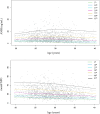Age-related Curves of AMH Using the Gen II, the picoAMH, and the Elecsys Assays in Women With Polycystic Ovary Syndrome
- PMID: 38486510
- PMCID: PMC11403310
- DOI: 10.1210/clinem/dgae153
Age-related Curves of AMH Using the Gen II, the picoAMH, and the Elecsys Assays in Women With Polycystic Ovary Syndrome
Abstract
Context: Several challenges still exist to adopt the anti-müllerian hormone (AMH) as a marker of polycystic ovary morphology, as included in the recently updated international guideline. Although different evaluations of age- and assay-specific reference ranges have been published in the past few years, these studies have mainly been conducted in normo-ovulatory or infertile women.
Objective: To develop an age-specific percentile distribution of AMH in patients with polycystic ovary syndrome (PCOS) measured by 3 different assays.
Design: Retrospective cross-sectional study.
Patients: A total of 2725 women aged 20 to 40 years with PCOS diagnosis were included.
Interventions: Serum AMH measurement by the Gen II (Beckman Coulter), the picoAMH (Ansh Labs), and the Elecsys (Roche) assays.
Main outcome measures: Age-specific percentile curves for all the assays and correlations between AMH, clinical, hormonal, and ultrasound characteristics.
Results: Age-related nomograms for the 5th, 10th, 25th, 50th, 75th, 90th, and 95th percentiles of AMH were calculated using the Lambda-Mu-Sigma method for all the assays. AMH levels were significantly different between PCOS phenotypes. AMH levels were positively correlated to LH, LH/FSH ratio, testosterone, androstenedione, free androgen index, mean follicular number, and mean ovarian volume.
Conclusion: To our knowledge, this is the first study reporting age-specific percentile nomograms of serum AMH levels measured by the Gen II, the picoAMH, and the Elecsys assays in a large population of women with PCOS. These findings may help to interpret AMH levels in patients with PCOS and facilitate the use of AMH as a diagnostic tool across age ranges.
Keywords: age; age-specific percentiles; anti-müllerian hormone (AMH); nomograms; polycystic ovary syndrome (PCOS).
© The Author(s) 2024. Published by Oxford University Press on behalf of the Endocrine Society.
Figures



Similar articles
-
Substituting serum anti-Müllerian hormone for polycystic ovary morphology increases the number of women diagnosed with polycystic ovary syndrome: a community-based cross-sectional study.Hum Reprod. 2021 Dec 27;37(1):109-118. doi: 10.1093/humrep/deab232. Hum Reprod. 2021. PMID: 34741176
-
Polycystic ovarian morphology and the diagnosis of polycystic ovary syndrome: redefining threshold levels for follicle count and serum anti-Müllerian hormone using cluster analysis.Hum Reprod. 2017 Aug 1;32(8):1723-1731. doi: 10.1093/humrep/dex226. Hum Reprod. 2017. PMID: 28854584
-
Age-specific reference values improve the diagnostic performance of AMH in polycystic ovary syndrome.Clin Chem Lab Med. 2020 Jul 28;58(8):1291-1301. doi: 10.1515/cclm-2019-1059. Clin Chem Lab Med. 2020. PMID: 32069226
-
Anti-müllerian hormone as a diagnostic biomarker for polycystic ovary syndrome and polycystic ovarian morphology: a systematic review and meta-analysis.Fertil Steril. 2024 Oct;122(4):727-739. doi: 10.1016/j.fertnstert.2024.05.163. Epub 2024 Jun 27. Fertil Steril. 2024. PMID: 38944177
-
Definition and significance of polycystic ovarian morphology: a task force report from the Androgen Excess and Polycystic Ovary Syndrome Society.Hum Reprod Update. 2014 May-Jun;20(3):334-52. doi: 10.1093/humupd/dmt061. Epub 2013 Dec 16. Hum Reprod Update. 2014. PMID: 24345633
Cited by
-
Bibliometric analysis of the research on anti-Müllerian hormone and polycystic ovary syndrome: current status, hotspots, and trends.Front Reprod Health. 2025 Apr 24;7:1519249. doi: 10.3389/frph.2025.1519249. eCollection 2025. Front Reprod Health. 2025. PMID: 40342310 Free PMC article.
-
Anti-Müllerian hormone a surrogate of follicular fluid oxidative stress in polycystic ovary syndrome?Front Cell Dev Biol. 2024 Jul 1;12:1408879. doi: 10.3389/fcell.2024.1408879. eCollection 2024. Front Cell Dev Biol. 2024. PMID: 39011395 Free PMC article.
-
Serum anti-mullerian hormone levels and age among Samoan women.Reprod Biol Endocrinol. 2025 Mar 19;23(1):45. doi: 10.1186/s12958-025-01379-y. Reprod Biol Endocrinol. 2025. PMID: 40108611 Free PMC article.
-
SmartScanPCOS: A feature-driven approach to cutting-edge prediction of Polycystic Ovary Syndrome using Machine Learning and Explainable Artificial Intelligence.Heliyon. 2024 Oct 11;10(20):e39205. doi: 10.1016/j.heliyon.2024.e39205. eCollection 2024 Oct 30. Heliyon. 2024. PMID: 39492914 Free PMC article.
-
Approach to the Patient: Diagnostic Challenges in the Workup for Polycystic Ovary Syndrome.J Clin Endocrinol Metab. 2025 Jun 17;110(7):e2298-e2308. doi: 10.1210/clinem/dgae910. J Clin Endocrinol Metab. 2025. PMID: 39836632 Free PMC article. Review.
References
-
- Rotterdam ESHRE/ASRM-Sponsored PCOS consensus workshop group . Revised 2003 consensus on diagnostic criteria and long-term health risks related to polycystic ovary syndrome (PCOS). Hum Reprod. 2004;19(1):41‐47. - PubMed
-
- Neven ACH, Laven J, Teede HJ, Boyle JA. A summary on polycystic ovary syndrome: diagnostic criteria, prevalence, clinical manifestations, and management according to the latest international guidelines. Semin Reprod Med. 2018;36(1):5‐12. - PubMed
-
- Dietz de Loos A, Hund M, Buck K, Meun C, Sillman J, Laven JSE. Antimüllerian hormone to determine polycystic ovarian morphology. Fertil Steril. 2021;116(4):1149‐1157. - PubMed
-
- Durlinger AL, Visser JA, Themmen AP. Regulation of ovarian function: the role of anti-müllerian hormone. Reproduction. 2002;124(5):601‐609. - PubMed
-
- Garg D, Tal R. The role of AMH in the pathophysiology of polycystic ovarian syndrome. Reprod Biomed Online. 2016;33(1):15‐28. - PubMed
MeSH terms
Substances
LinkOut - more resources
Full Text Sources
Medical
Research Materials
Miscellaneous

